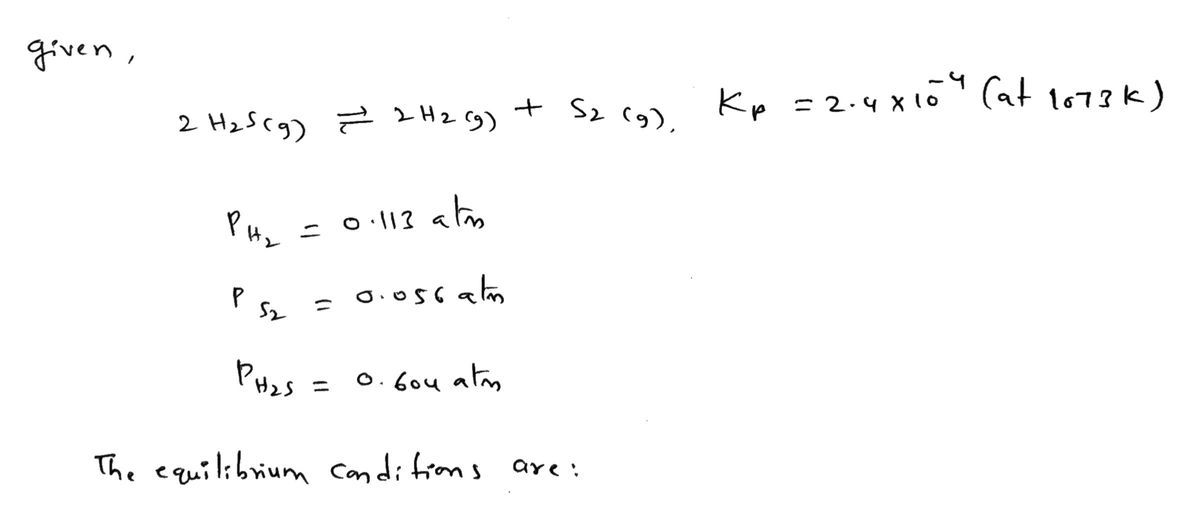Consider the reaction is at 2H₂S(g) is not at A reaction mixture contains 0.113 atm of H₂, 0.056 atm of S2, and 0.604 atm of H₂S. Determine how these conditions compare to equilibrium conditions. Match the words in the left column to the appropriate blanks in the sentences on the right. does not need to shift will shift to the left 2H₂(g) + S₂(g), will shift to the right Kp = 2.4 × 10-4 (at 1073 K) The system equilibrium, and the reaction I Res to reach equilibrium.
Consider the reaction is at 2H₂S(g) is not at A reaction mixture contains 0.113 atm of H₂, 0.056 atm of S2, and 0.604 atm of H₂S. Determine how these conditions compare to equilibrium conditions. Match the words in the left column to the appropriate blanks in the sentences on the right. does not need to shift will shift to the left 2H₂(g) + S₂(g), will shift to the right Kp = 2.4 × 10-4 (at 1073 K) The system equilibrium, and the reaction I Res to reach equilibrium.
Chemistry
10th Edition
ISBN:9781305957404
Author:Steven S. Zumdahl, Susan A. Zumdahl, Donald J. DeCoste
Publisher:Steven S. Zumdahl, Susan A. Zumdahl, Donald J. DeCoste
Chapter1: Chemical Foundations
Section: Chapter Questions
Problem 1RQ: Define and explain the differences between the following terms. a. law and theory b. theory and...
Related questions
Question
100%
Please answer fast!
![### Reaction and Equilibrium Analysis
**Consider the reaction:**
\[ 2\text{H}_2\text{S}(\text{g}) \rightleftharpoons 2\text{H}_2(\text{g}) + \text{S}_2(\text{g}), \quad K_p = 2.4 \times 10^{-4} \, (\text{at 1073 K}) \]
**Initial Conditions of the Reaction Mixture:**
- \(\text{H}_2\) = 0.113 atm
- \(\text{S}_2\) = 0.056 atm
- \(\text{H}_2\text{S}\) = 0.604 atm
**Objective:**
Determine how these conditions compare to the equilibrium conditions.
**Activity:**
**Match the words in the left column to the appropriate blanks in the sentence on the right:**
- **Options:**
- is at
- is not at
- does not need to shift
- will shift to the left
- will shift to the right
- **Sentence:**
- "The system [___] equilibrium, and the reaction [___] to reach equilibrium."
**Instructions:**
Select the appropriate options to complete the sentence based on the given reaction conditions and equilibrium constant.](/v2/_next/image?url=https%3A%2F%2Fcontent.bartleby.com%2Fqna-images%2Fquestion%2F04b28093-4f77-4d69-adb9-9e4a8e9f1bf0%2F5b82d10f-316d-4972-a717-0c126730e2b2%2Fwl4fz3j_processed.jpeg&w=3840&q=75)
Transcribed Image Text:### Reaction and Equilibrium Analysis
**Consider the reaction:**
\[ 2\text{H}_2\text{S}(\text{g}) \rightleftharpoons 2\text{H}_2(\text{g}) + \text{S}_2(\text{g}), \quad K_p = 2.4 \times 10^{-4} \, (\text{at 1073 K}) \]
**Initial Conditions of the Reaction Mixture:**
- \(\text{H}_2\) = 0.113 atm
- \(\text{S}_2\) = 0.056 atm
- \(\text{H}_2\text{S}\) = 0.604 atm
**Objective:**
Determine how these conditions compare to the equilibrium conditions.
**Activity:**
**Match the words in the left column to the appropriate blanks in the sentence on the right:**
- **Options:**
- is at
- is not at
- does not need to shift
- will shift to the left
- will shift to the right
- **Sentence:**
- "The system [___] equilibrium, and the reaction [___] to reach equilibrium."
**Instructions:**
Select the appropriate options to complete the sentence based on the given reaction conditions and equilibrium constant.
Expert Solution
Step 1

Step by step
Solved in 3 steps with 3 images

Knowledge Booster
Learn more about
Need a deep-dive on the concept behind this application? Look no further. Learn more about this topic, chemistry and related others by exploring similar questions and additional content below.Recommended textbooks for you

Chemistry
Chemistry
ISBN:
9781305957404
Author:
Steven S. Zumdahl, Susan A. Zumdahl, Donald J. DeCoste
Publisher:
Cengage Learning

Chemistry
Chemistry
ISBN:
9781259911156
Author:
Raymond Chang Dr., Jason Overby Professor
Publisher:
McGraw-Hill Education

Principles of Instrumental Analysis
Chemistry
ISBN:
9781305577213
Author:
Douglas A. Skoog, F. James Holler, Stanley R. Crouch
Publisher:
Cengage Learning

Chemistry
Chemistry
ISBN:
9781305957404
Author:
Steven S. Zumdahl, Susan A. Zumdahl, Donald J. DeCoste
Publisher:
Cengage Learning

Chemistry
Chemistry
ISBN:
9781259911156
Author:
Raymond Chang Dr., Jason Overby Professor
Publisher:
McGraw-Hill Education

Principles of Instrumental Analysis
Chemistry
ISBN:
9781305577213
Author:
Douglas A. Skoog, F. James Holler, Stanley R. Crouch
Publisher:
Cengage Learning

Organic Chemistry
Chemistry
ISBN:
9780078021558
Author:
Janice Gorzynski Smith Dr.
Publisher:
McGraw-Hill Education

Chemistry: Principles and Reactions
Chemistry
ISBN:
9781305079373
Author:
William L. Masterton, Cecile N. Hurley
Publisher:
Cengage Learning

Elementary Principles of Chemical Processes, Bind…
Chemistry
ISBN:
9781118431221
Author:
Richard M. Felder, Ronald W. Rousseau, Lisa G. Bullard
Publisher:
WILEY